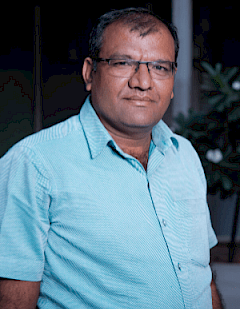Faculty

Dharamashi Rabari
Assistant Professor
PhD (Indian Institute of Technology, Guwahati)
+91.79.61911170
Research Interests: Ionic Liquids Applications, Extraction Based Separation, Equation Of State Modelling, Stochastic Optimization, Molecular Simulation.
Profile
Dharamashi Rabari is an Assistant Professor at the School of Engineering and Applied Science, Ahmedabad University. He has completed his PhD (Chemical Engineering) at IIT Guwahati. Prior to his doctoral study, he worked as an Assistant Professor at Institute of Diploma Studies, Nirma University and G H Patel College of Engineering and Technology, Vallabh Vidyanagar for five years. He obtained his M. Tech. in Chemical Engineering from Nirma University in 2008 and his B.E. in Chemical Engineering from Gujarat University in 2005.
His research interests are in the fields of Ionic Liquids applications, extraction-based separation, equation of state modelling, process simulation and optimization. He is also interested in molecular simulation.
Research
Thermodynamics:
Generally Cubic Equation Of State (CEOS) represents PVT behaviour of gases and liquids. CEOS can be combined with different equilibrium criteria (Fugacity, Activity Coefficient) for the prediction of properties like density, Vapor Liquid Equilibrium (VLE) data and Henry's Constant etc. The density of different ILs as a function of tempreature has been predicted using Predictive SRK EOS with different alpha functions. The Vapor Liquid Equilibrium (VLE) behavior of CO2 with different solvents (Six Organic Solvents + Six Ionic Liquids) have been predicted using Peng Robinson (PR) EOS.
Separation:
Butanol can be considered as alternative energy source. The well-known process Acetone-Butanol-Ethanol (ABE) fermentation produces all three organic compounds under anaerobic conditions. The increasing concentration of alcohols deactivates the growth of micro-organisms. Hence the simultaneous removal of butanol and ethanol is required for higher productivity. Phosphonum based hydrophobic ILs were used as solvents for extraction of alcohols from water. To study extraction efficiency, the equilibrium data (tie line data) were generated for three systems. The equilbrium data were correlated with Gibbs's free energy models (NRTL and UNIQUAC). The equilbrium data were also predicted with COSMO-SAC model.
Optimization:
Particle Swarm Optimization (PSO) is an evolutionary algorithm based on social behavior of birds in swarm. PSO is robust as it evaluates fewer function values during the simulation as compared to Genetic Algorithm (GA). PSO was used for the optimization of multistage counter current extractor with Isothermal Sum Rate (ISR) method. ISR calculates the stagewise compositions and flow rates in separation unit. Binary Interaction Parameters generated by NRTL model (correlating experimental equilibrium data) were used as input variables in ISR. The total extractor cost were optimized with solvent flow rate and number of stages as variables. The effect of population size and inertia weight on the solution quality were also studied.
Molecular Dynamics:
Molecular Dynamics is a simulation based on the interaction of atoms/molecules. It proceeds through different steps; minimization, equilibration and production. Newton's law of motion are used to study atoms trajectory. The forces between particles are defined by force field. The density of pure IL and water-IL miscibility were studied by MD in NAMD freeware considering OPLS-All Atoms force field. Intially IL structures prepared and optimized in GAUSSIAN. The optimized molecules were placed in simulation box with providig pereodic boundary conditions. The deviation in predicted density from experimental values was within 5%.
Publications
Book
- Anand Bharti, Debashis Kundu, Dharamashi Rabari, Tamal Banerjee, "Phase Equilibria in Ionic Liquid Facilitated Liquid-Liquid Extractions", CRC Press, 2017.
- Dharamashi Rabari, Tamal Banerjee. "Biobutanol and n-propanol Recovery using a low density phosphonium based Ionic liquid at T=298.15 K and p=1 atm", Fluid Phase Equilibria 355 (2013) 26–33.
- C.V. Manohar, Dharamashi Rabari, A. Ananth Praveen Kumar, Tamal Banerjee, Kaustubha Mohanty, “Liquid–liquid equilibria studies on ammonium and phosphonium based ionic liquid–aromatic–aliphatic component at T = 298.15 K and p = 1 bar: Correlations and a-priori predictions”, Fluid Phase Equilibria 360 (2013) 392– 400.
- Dharamashi Rabari, Nikunj Patel, Milind Joshipura, Tamal Banerjee, “Densities of Six Commercial Ionic Liquids: Experiments and Prediction Using a Cohesion Based Cubic Equation of State”, Journal of Chemical and Engineering Data 59 (2014) 571–578.
- Dharamashi Rabari, Tamal Banerjee, “Experimental and Theoretical Studies on the Effectiveness of Phosphonium-Based Ionic Liquids for Butanol Removal at T = 298.15 K and p = 1 atm”, Industrial and Engineering Chemistry Research 53 (2014) 18935-18942.
- Hiral Bhatt, Supritam Dutta, Tamal Banerjee, Dharamashi Rabari, "Kinetic study of non-catalytic methane decomposition using quantum calculation", International Workshop on Introduction to Gaussian, 2017, New Delhi, Gussian Inc. USA.
Teaching
Monsoon 2015-16:
- Thermodynamics-1
- Petroleum Refining and Petrochemicals
- Thermodynamics-2
- Chemical Engineering Laboratory-III
- Optimization Methods
- Process Simulation
Professional Service
- Chair, UG Program, SEAS
- President, NIDSAA (Nirma Institute of Diploma Studies Alumni Association) during 2016-2018
- Member (Life Time), Indian Society for Technical Education
